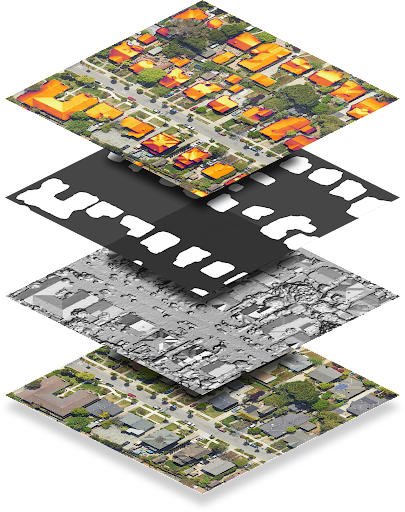
نقطه پایانی dataLayers دادههای کدگذاری شده به صورت فایلهای GeoTIFF را برمیگرداند که میتوانند در هر برنامه سیستم اطلاعات جغرافیایی (GIS) برای طراحی سیستمهای خورشیدی مورد استفاده قرار گیرند.
هر رشته در پاسخ dataLayers شامل یک URL است که میتوانید از آن برای دریافت GeoTIFF مربوطه استفاده کنید. URLها تا یک ساعت پس از تولید از درخواست لایههای داده اصلی معتبر هستند. فایلهای GeoTIFF را میتوان تا 30 روز ذخیره کرد.
به استثنای لایه RGB، فایلهای GeoTIFF به درستی با یک نمایشگر تصویر نمایش داده نمیشوند، زیرا محتوا به جای تصاویر RGB، دادههای رمزگذاری شده هستند. فایلهای GeoTIFF همچنین نمیتوانند مستقیماً به عنوان یک تصویر روی هم قرار گرفته با Maps Javascript API استفاده شوند.
جدول زیر هر لایه را به تفصیل شرح میدهد.
| لایه | عمق پیکسل | وضوح تصویر | توضیحات |
|---|---|---|---|
| مدل سطح دیجیتال (DSM) | عدد اعشاری ۳۲ بیتی | ۰.۱ متر بر پیکسل | دادههای ارتفاعی که نشان دهنده توپوگرافی سطح زمین، شامل عوارض طبیعی و ساخته شده است. مقادیر بر حسب متر از سطح دریا هستند. مکانهای نامعتبر یا مناطقی که دادهای در مورد آنها نداریم، با مقدار -9999 ذخیره میشوند. |
| آر جی بی | ۸ بیتی | ۰.۱ متر بر پیکسل ۰.۲۵ متر بر پیکسل | یک تصویر هوایی یا ماهوارهای از منطقه. فایل تصویر GeoTIFF شامل سه باند مربوط به مقادیر قرمز، سبز و آبی است تا مقدار RGB 24 بیتی برای هر پیکسل تشکیل شود. به طور پیشفرض، وضوح پیکسل 0.1 متر بر پیکسل است. |
| ماسک ساختمانی | ۱ بیتی | ۰.۱ متر بر پیکسل | یک بیت در هر پیکسل که نشان میدهد آیا آن پیکسل بخشی از پشت بام محسوب میشود یا خیر. |
| شار سالانه | عدد اعشاری ۳۲ بیتی | ۰.۱ متر بر پیکسل | نقشه شار سالانه یا میزان تابش سالانه نور خورشید بر روی پشت بامهای منطقه. مقادیر بر حسب کیلووات ساعت بر کیلووات ساعت بر سال هستند. شار برای هر مکانی محاسبه میشود، نه فقط پشت بام ساختمانها. مکانهای نامعتبر یا مناطقی که نتوانستیم شار را محاسبه کنیم، با مقدار -۹۹۹۹ ذخیره میشوند. مکانهای خارج از منطقه پوشش ما نامعتبر هستند. توجه: این شار بدون پوشش است. |
| جریان ماهانه | عدد اعشاری ۳۲ بیتی | 0.5 متر بر پیکسل | نقشه شار ماهانه (نور خورشید روی پشت بامها، به تفکیک ماه) منطقه. مقادیر بر حسب کیلووات ساعت بر کیلووات ساعت در سال هستند. فایل تصویر GeoTIFF شامل ۱۲ باند مربوط به ژانویه - دسامبر است. |
| سایه ساعتی | عدد صحیح ۳۲ بیتی | ۱ متر بر پیکسل | ۱۲ آدرس اینترنتی برای نقشههای سایه ساعتی مربوط به ژانویه - دسامبر، به ترتیب. هر فایل GeoTIFF شامل ۲۴ باند است که مربوط به ۲۴ ساعت شبانهروز است. هر پیکسل یک عدد صحیح ۳۲ بیتی است که مربوط به (حداکثر) ۳۱ روز آن ماه است. بیت ۱ به این معنی است که مکان مربوطه قادر به دیدن خورشید در آن روز، در آن ساعت، در آن ماه است. مکانهای نامعتبر به صورت -9999 ذخیره میشوند و بیت ۳۱ روی آنها تنظیم شده است، زیرا این بیت مربوط به روز سی و دوم ماه است و بنابراین نامعتبر است. |
رمزگشایی رسترهای سایه ساعتی
دادههای سایه ساعتی در رسترهای چندبانده کدگذاری میشوند. برای کسب اطلاعات بیشتر در مورد اصول اولیه رستر، به مفاهیم API خورشیدی مراجعه کنید.
وقتی درخواست دادههای سایه ساعتی را میدهید، میتوانید تا ۱۲ رستر دریافت کنید، یکی برای هر ماه از سال تقویمی (ژانویه تا دسامبر). هر رستر از ۲۴ لایه یا نوار تشکیل شده است که مربوط به ۲۴ ساعت شبانهروز است.
هر باند توسط ماتریسی از سلولها یا پیکسلها نمایش داده میشود. هر پیکسل عمقی معادل ۳۲ بیت دارد که متناظر با (حداکثر) ۳۱ روز ماه است. بنابراین، رمزگشایی دادههای روز، زمان و ماه سایه، مستلزم درک بیت، باند و رستری است که در حال تجزیه و تحلیل آن هستید.
برای مثال، برای تشخیص اینکه آیا یک مکان مشخص در مختصات (x, y) خورشید را در ساعت 4 بعد از ظهر 22 ژوئن دیده است یا خیر، مراحل زیر را انجام دهید:
- برای همه لایهها در موقعیت (x, y) درخواست لایههای داده ارسال کنید.
- از آنجا که ماه ژوئن ششمین ماه سال است، ششمین URL را در لیست
hourlyShadeUrlsدریافت کنید. - باندهای ساعتی به صورت ۲۴ ساعته ارائه میشوند. برای دریافت دادهها برای ساعت ۴:۰۰ بعد از ظهر (۱۶:۰۰)، کانال هفدهم را جستجو کنید.
- اندیس بیتها (روزها) از ۰. برای دریافت دادههای مربوط به روز ۲۲ ژوئن، بیت ۲۱ را بخوانید.
- بیتها دادههای دودویی ارائه میدهند که نشان میدهد آیا آن مکان در تاریخ و زمان مشخص شده، خورشید را دیده است یا خیر. اگر بیت ۱ باشد، آن مکان خورشید را دیده است. اگر بیت ۰ باشد، آن مکان سایه را دیده است.
کد زیر مراحل بالا را خلاصه میکند:
(hourly_shade[month - 1])(x, y)[hour] & (1 << (day - 1))

